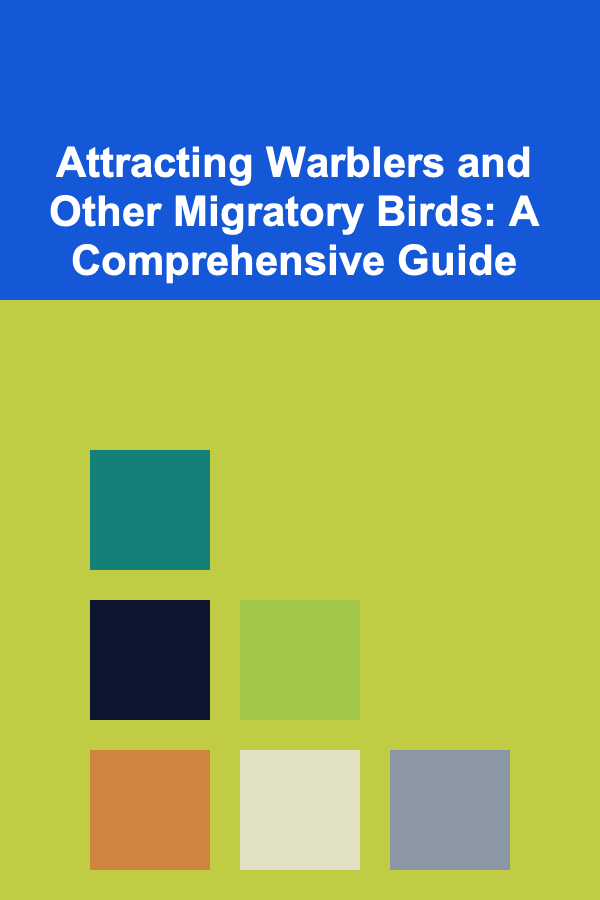
Attracting Warblers and Other Migratory Birds: A Comprehensive Guide
ebook include PDF & Audio bundle (Micro Guide)
$12.99$10.99
Limited Time Offer! Order within the next:

Migratory birds, especially warblers, are jewels of the avian world, adding vibrant colors and enchanting songs to our ecosystems. Their epic journeys, spanning continents, are a testament to nature's resilience and a powerful reminder of the interconnectedness of life. However, migratory birds face increasing challenges, including habitat loss, climate change, and collisions with human-made structures. By understanding their needs and implementing thoughtful strategies, we can transform our gardens and landscapes into welcoming havens that support these remarkable creatures during their crucial migratory stopovers and breeding seasons.
Understanding Migratory Bird Needs
To effectively attract migratory birds, it's essential to understand their fundamental requirements. These birds are often under immense pressure, depleted from long flights and facing the urgency of finding food and shelter to replenish their energy reserves or prepare for breeding. Meeting these needs is paramount to ensuring their survival and continued presence in our environment.
Food Resources
Migratory birds require a diverse and abundant food supply to fuel their journeys. Their diets vary depending on the species and the time of year. Generally, they can be categorized as:
- Insects: Warblers, in particular, are insectivores, relying heavily on caterpillars, aphids, beetles, and other insects. Providing a habitat that supports insect populations is crucial.
- Fruits and Berries: Many migratory birds, including thrushes, tanagers, and some warblers, supplement their diets with fruits and berries. Native berry-producing shrubs and trees are excellent additions to any bird-friendly landscape.
- Seeds: Seed-eating birds, such as sparrows, finches, and buntings, benefit from native seed-bearing plants and supplemental feeders.
- Nectar: Hummingbirds are obligate nectarivores, relying almost entirely on flower nectar for energy.
Water Sources
Fresh water is essential for drinking and bathing. Migratory birds, often stressed by their long flights, readily utilize reliable water sources. Ponds, bird baths, and even shallow dishes of water can provide critical hydration and opportunities for preening, which helps maintain feather health.
Shelter and Cover
Shelter is vital for protection from predators and harsh weather. Dense shrubs, trees, and groundcover offer safe havens for birds to rest, forage, and nest. Layered vegetation, mimicking a natural forest edge, provides optimal cover for a variety of species.
Nesting Sites
For breeding birds, suitable nesting sites are essential. Different species have different nesting preferences. Some prefer tree cavities, others build nests in shrubs or on the ground, and some even use artificial structures like birdhouses. Providing a range of nesting options will attract a wider variety of birds.
Creating a Bird-Friendly Habitat
The most effective way to attract migratory birds is to create a habitat that mimics their natural environment. This involves selecting native plants, providing diverse food sources, offering clean water, and creating safe shelter. The following strategies can help you transform your yard or garden into a bird-friendly paradise.
Planting Native Plants
Native plants are the cornerstone of a bird-friendly habitat. They are adapted to the local climate and soil conditions, requiring less maintenance and providing the specific food and shelter that native birds have evolved to depend on. Native plants also support a greater diversity of insects, a crucial food source for many migratory birds, especially warblers.
- Trees: Native trees provide shade, shelter, nesting sites, and food. Consider planting trees such as oaks (Quercus spp.), maples (Acer spp.), birches (Betula spp.), and pines (Pinus spp.). These trees support a wide range of insects and offer excellent nesting opportunities.
- Shrubs: Native shrubs provide dense cover, nesting sites, and fruits. Excellent choices include viburnums (Viburnum spp.), dogwoods (Cornus spp.), serviceberries (Amelanchier spp.), and elderberries (Sambucus spp.).
- Flowers: Native wildflowers provide nectar for hummingbirds and attract insects for insectivorous birds. Consider planting coneflowers (Echinacea spp.), asters (Aster spp.), goldenrods (Solidago spp.), and milkweeds (Asclepias spp.).
- Grasses and Groundcovers: Native grasses and groundcovers provide shelter for ground-nesting birds and insects. Consider planting little bluestem (Schizachyrium scoparium), switchgrass (Panicum virgatum), and wild strawberries (Fragaria virginiana).
When selecting native plants, choose a variety of species that bloom and fruit at different times of the year to provide a continuous food supply for migratory birds. Research plants that are native to your specific region to ensure they are well-suited to your local environment.
Providing Food Sources
In addition to native plants, you can supplement food sources with bird feeders. However, it's important to choose the right type of feeder and food to attract specific species and to maintain feeders properly to prevent the spread of disease.
- Seed Feeders: Tube feeders and hopper feeders are suitable for seed-eating birds such as sparrows, finches, and buntings. Offer a variety of seeds, including black oil sunflower seeds, white millet, and nyjer seeds.
- Suet Feeders: Suet is a high-energy food source that is particularly attractive to woodpeckers, nuthatches, and chickadees. Offer suet cakes in wire cages.
- Nectar Feeders: Hummingbird feeders should be filled with a solution of one part white sugar to four parts water. Clean the feeders regularly to prevent mold and bacteria growth.
- Fruit Feeders: Some birds, such as orioles and tanagers, enjoy eating fruit. Offer sliced oranges, grapes, and berries on platform feeders.
Avoid using pesticides, herbicides, and insecticides in your garden. These chemicals can harm birds directly or indirectly by reducing their food supply. Instead, use natural pest control methods such as attracting beneficial insects and practicing crop rotation.
Offering Clean Water
Provide a reliable source of clean water for birds to drink and bathe. A simple bird bath is an excellent addition to any bird-friendly garden. Choose a bird bath that is shallow and has a rough surface to provide secure footing for birds. Clean the bird bath regularly to prevent algae growth and the spread of disease.
In addition to bird baths, you can also create a small pond or stream in your garden. Moving water is particularly attractive to birds and helps to prevent mosquito breeding. Consider adding a small fountain or waterfall to your pond to create a more inviting environment.
Creating Shelter and Nesting Sites
Provide a variety of shelter options for birds, including dense shrubs, trees, and groundcover. Layered vegetation, with a mix of trees, shrubs, and groundcovers, provides optimal cover for a variety of species. Consider planting evergreen trees and shrubs to provide shelter during the winter months.
You can also provide artificial nesting sites by putting up birdhouses. Different species have different nesting preferences, so choose birdhouses that are appropriate for the birds you want to attract. Place birdhouses in sheltered locations, away from predators and direct sunlight.
Leave some leaf litter on the ground in the fall. Leaf litter provides habitat for insects and other invertebrates, which are an important food source for birds. It also provides shelter for ground-nesting birds and insects.
Specific Strategies for Attracting Warblers
Warblers are a particularly diverse and beautiful group of migratory birds. They are primarily insectivorous and often require specific habitat features to thrive. Attracting warblers requires a focus on supporting healthy insect populations and providing the right type of vegetation.
Caterpillar Power: The Key to Warbler Abundance
Caterpillars are a critical food source for many warblers, especially during the breeding season when they need to feed their young. Native trees, particularly oaks, are known to support a large number of caterpillar species. Planting oaks and other native trees that support caterpillars is one of the most effective ways to attract warblers.
Avoid using broad-spectrum insecticides that kill caterpillars. Instead, use targeted pest control methods if necessary. Consider tolerating some caterpillar damage on your trees, as it is a sign that you are providing a valuable food source for warblers.
Shrubby Habitat: A Warbler's Paradise
Many warblers prefer shrubby habitats with dense vegetation. Planting a mix of native shrubs and trees creates a layered habitat that provides excellent foraging and nesting opportunities for warblers. Consider planting shrubs such as viburnums, dogwoods, and serviceberries.
Prune shrubs and trees to create a dense, bushy growth habit. This provides more cover and foraging opportunities for warblers. Avoid pruning during the nesting season to avoid disturbing nesting birds.
Water Features: A Warbler's Oasis
Warblers often forage near water sources, where insects are more abundant. Providing a small pond, stream, or even a bird bath can attract warblers to your garden. Place the water feature near shrubs and trees to provide cover and foraging opportunities.
Consider adding a dripper or mister to your water feature to create a constant supply of fresh water. This is particularly attractive to warblers, who often drink by sipping water droplets from leaves and branches.
Patience and Observation
Attracting warblers and other migratory birds takes time and patience. It may take several years for your habitat to mature and attract a diverse array of birds. Observe your garden regularly to see which birds are visiting and what they are eating. Adjust your strategies accordingly to provide the best possible habitat for migratory birds.
Protecting Migratory Birds Beyond Your Backyard
While creating a bird-friendly habitat in your own yard is a great start, it's also important to support conservation efforts that protect migratory birds on a larger scale. This includes advocating for policies that protect habitat, reduce pesticide use, and mitigate the effects of climate change.
Supporting Conservation Organizations
Many organizations are working to protect migratory birds and their habitats. Consider supporting these organizations through donations or volunteer work. These organizations play a crucial role in research, education, and advocacy.
Reducing Light Pollution
Light pollution can disorient migratory birds and cause them to collide with buildings and other structures. Reduce light pollution by turning off unnecessary lights at night and using shielded light fixtures that direct light downward. Advocate for policies that reduce light pollution in your community.
Reducing Window Collisions
Window collisions are a major cause of bird mortality. Birds often mistake reflections in windows for open sky or vegetation. Reduce window collisions by applying decals, stickers, or netting to your windows. Consider using bird-safe glass or screens.
Supporting Sustainable Practices
Support sustainable practices that protect habitat and reduce pollution. This includes buying local and organic food, reducing your carbon footprint, and advocating for policies that promote environmental sustainability.
The Rewarding Experience of Bird Conservation
Attracting warblers and other migratory birds is a rewarding experience that connects us to the natural world. By creating a bird-friendly habitat, we can provide vital resources for these remarkable creatures and contribute to their conservation. The vibrant colors, enchanting songs, and fascinating behaviors of migratory birds enrich our lives and remind us of the importance of protecting our planet's biodiversity.
By understanding their needs, implementing thoughtful strategies, and supporting conservation efforts, we can ensure that migratory birds continue to grace our landscapes for generations to come. The journey to attract these feathered travelers is not just about creating a beautiful garden; it's about fostering a deeper connection with nature and playing an active role in protecting our planet's invaluable biodiversity. So, roll up your sleeves, plant those native species, and prepare to be captivated by the beauty and resilience of migratory birds.

How to Create a Home Office Space During Your Renovation
Read More
How to Make Pet-Friendly Decorations for Your Home
Read More
How to Properly Maintain Your Roof to Prevent Leaks
Read More
How to Set Up a Checklist for Identifying Development Needs from Your Performance Evaluation
Read More
How To Save Money on Car Maintenance
Read More
How to Find TV Shows That Are Genuinely Scary
Read MoreOther Products

How to Create a Home Office Space During Your Renovation
Read More
How to Make Pet-Friendly Decorations for Your Home
Read More
How to Properly Maintain Your Roof to Prevent Leaks
Read More
How to Set Up a Checklist for Identifying Development Needs from Your Performance Evaluation
Read More
How To Save Money on Car Maintenance
Read More